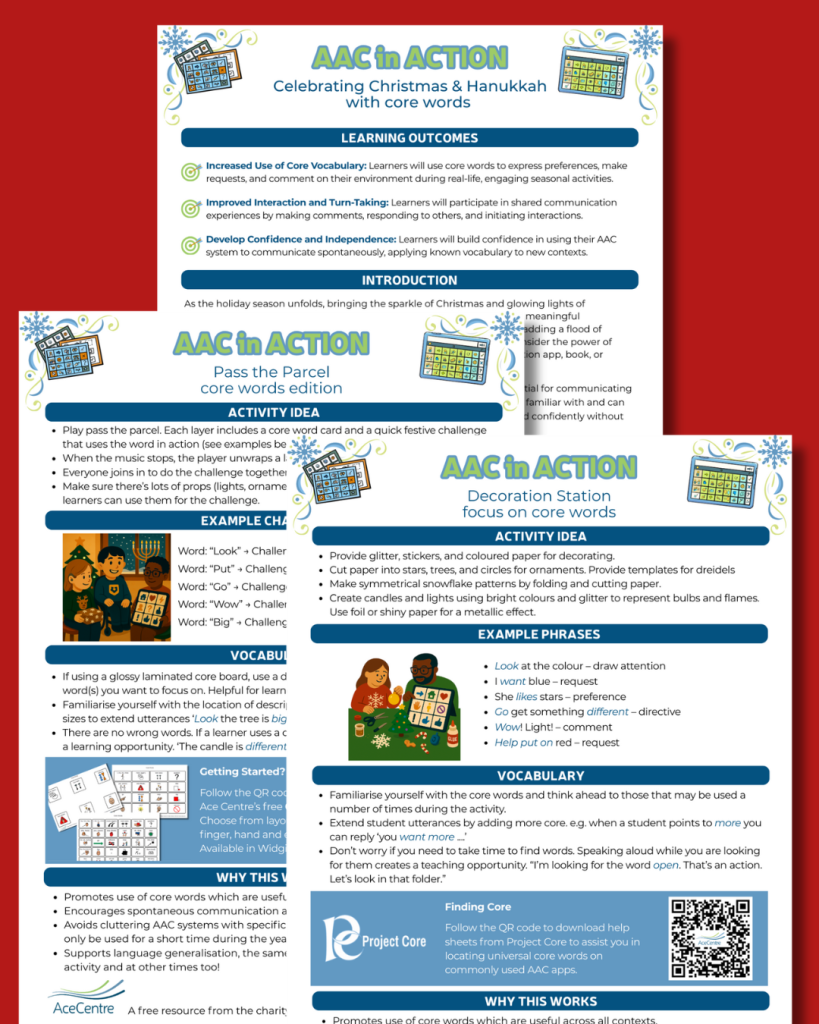Deck the Halls with Core Words
Deck the Halls with Core Words: Maximising AAC Communication This Festive Season
As the holiday season unfolds, bringing the sparkle of Christmas and the glowing lights of Hanukkah, it presents a perfect opportunity to engage AAC users in rich, meaningful communication. However, when preparing for these events, rather than immediately adding a flood of seasonal-specific vocabulary (fringe words) to a learner’s AAC system, we should consider the power of focusing on core and familiar words already present in their communication app, book, or symbol chart.
The Power of Everyday Language
Core words—such as more, want, like, stop, and different—are highly flexible and essential for talking about almost any holiday activity. By focusing on vocabulary learners are familiar with and can use across many contexts, they can express themselves more fluently and confidently without the cognitive load of navigating unfamiliar or rarely-used vocabulary.
Think about how core words fit into festive activities:
- Decorating: Look at the lights! Try a different colour. Do you want more candles?
- Festive music: Do you like this song? Play it again. Stop, too loud!
- Baking treats: Add more sprinkles! Help stir. Do you like it?
This approach reinforces core vocabulary development and encourages AAC users to generalise language across contexts, making their communication more robust and flexible. Seasonal events transform into opportunities to practice everyday language in exciting new settings, rather than requiring staff to spend time inputting niche words that may only be used once a year.
Using core words during seasonal events is like practicing scales in music: you’re reinforcing the essential techniques that allow you to play any song, rather than just memorizing one complex holiday piece that you’ll forget until next year.
Modelling: The Key to Success
Learners begin to understand how to use symbols by seeing others using them. You need to use the communication charts yourself, pointing to symbols while you talk and interact with the learner. If a learner points to want and a decoration, you can reinforce learning by replying “you want more decorations” while pointing to the corresponding symbols. Don’t worry if you need to take time to find words; speaking aloud while you are looking for them creates a teaching opportunity.
Inclusive Communication for All
Ace Centre supports this inclusive approach by offering freely downloadable Core symbol charts. These resources are designed to increase a learner’s engagement and success with symbols by bringing them into fun, motivating activities.
Crucially, Ace Centre provides layouts that specifically support finger, hand and eye pointing. For learners who find pointing with a finger difficult, these resources are adapted to include them. For instance, the eye-pointing charts are designed to enable learners to use their eyes to point to symbols. The chart includes a central opening, which helps the communication partner look through to maintain eye contact and follow where the learner is looking. These accessible charts, available in Widgit and PCS symbols, promote the use of core words useful across all contexts, encourage spontaneous communication, and motivate learners to use their AAC systems with confidence.
This holiday season, let’s focus on foundational core words—the building blocks that allow everyone to express joy, choice, and opinion throughout the celebrations!
Explore our downloadable AAC in Action: Christmas and Hanukkah resource pack—packed with activity ideas and practical suggestions for modelling meaningful vocabulary. These resources are designed to inspire engaging, real-life communication opportunities that motivate learners to use their AAC systems with confidence.
Written by Tina Voizey, Information and Resources Manager at Ace Centre. She has over 30 years’ experience working with learners with complex disabilities, many of whom use AAC in all its forms. She has had a diverse career which has taken her from teaching in a classroom, to working for suppliers of symbol software and AAC solutions.



Follow Ace Centre on social media
Follow us on Twitter
Watch our latest videos via our YouTube channel here
Like us on Facebook here